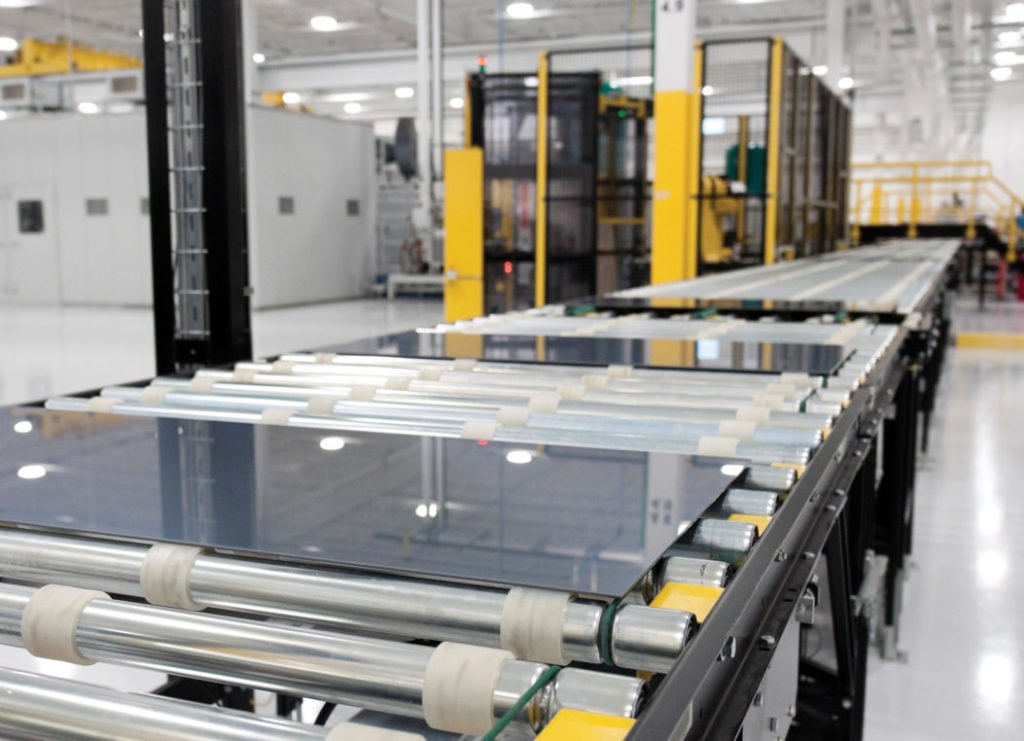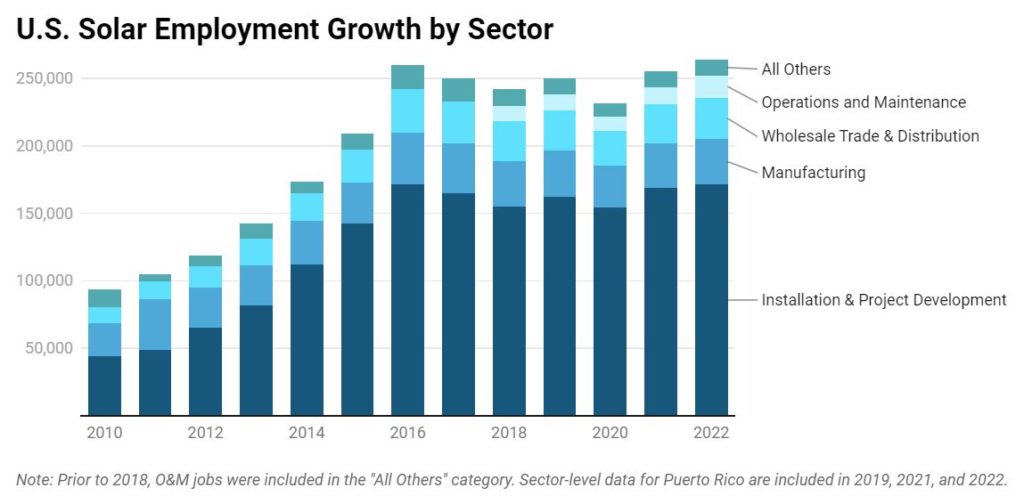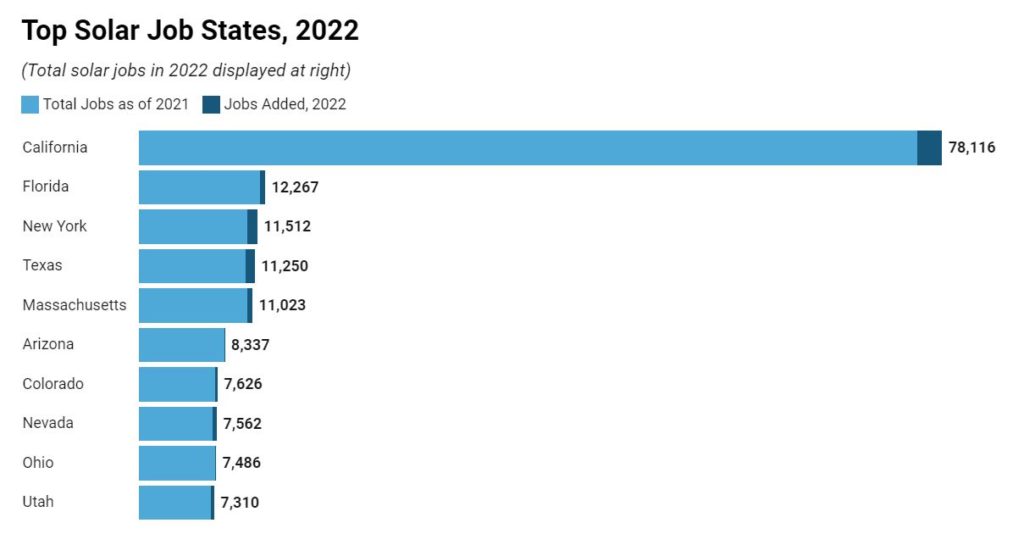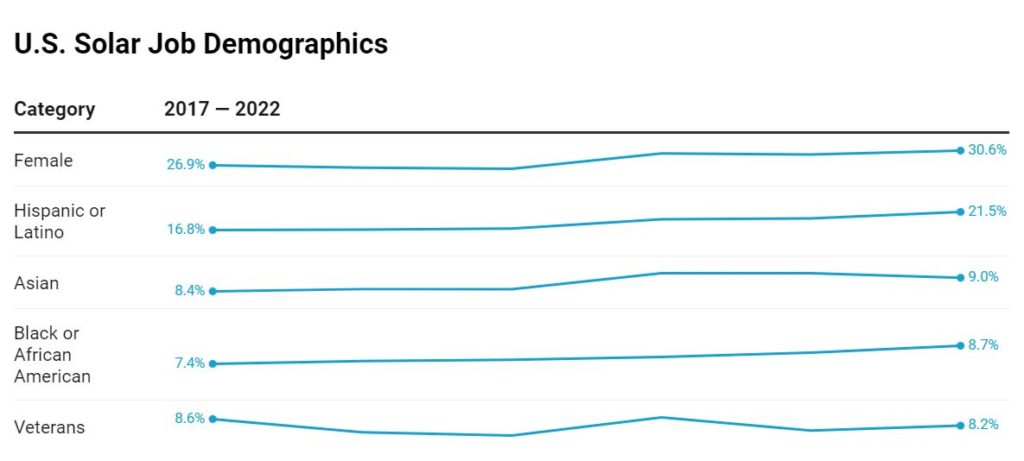
The Interstate Renewable Energy Council (IREC), a non-profit solar renewable power organisation based in the US, has released the latest edition of its National Solar Jobs Census, revealing a 3.5% growth in the number of jobs in the US solar sector between 2021 and 2022.
According to the latest edition of the census, which covers the US solar sector in 2022, there were 263,883 solar workers across all 50 US states, in addition to the District of Columbia and Puerto Rico. Of these jobs, 171,558 were at installation and project developments, around two-thirds of all US solar jobs, alongside 33,473 in manufacturing, 30,618 in wholesale trade and distribution and 16,585 in operations and maintenance.
Unlock unlimited access for 12 whole months of distinctive global analysis
Photovoltaics International is now included.
- Regular insight and analysis of the industry’s biggest developments
- In-depth interviews with the industry’s leading figures
- Unlimited digital access to the PV Tech Power journal catalogue
- Unlimited digital access to the Photovoltaics International journal catalogue
- Access to more than 1,000 technical papers
- Discounts on Solar Media’s portfolio of events, in-person and virtual
2022 was the year with the highest number of jobs available in the installation and project development sectors, greater than the 171,533 available in 2016, the year with the previous high in total solar jobs. However, in 2016, more jobs were available in manufacturing and wholesale trade and distribution, and the shifting of new jobs out of these sectors, and into the manufacturing sector, exemplifies the trend towards domestically-produced solar equipment prioritised by the Inflation Reduction Act.
This shift was echoed by the Solar Energy Industries Association (SEIA), a trade body based in the US, that announced that the number of solar manufacturing jobs in the country will more than treble in the next ten years.
“The manufacturing renaissance over the past couple years has had a staggering effect on national solar job creation,” said Dan Shugar, founder and CEO of solar tracker manufacturer Nextracker. “We’re extremely proud to have played a part in creating hundreds of well-paying solar jobs through the development of a robust local supply chain from Arizona to Texas-further strengthening local economies.”
However, the IREC census found that total solar manufacturing jobs increased “only slightly” between 2021 and 2022, with most of the growth taking place in other sectors, suggesting that the growth in the number of manufacturing jobs will need to improve in order to meet the US’ clean energy goals.
Most of the new job growth in 2022 came in the residential sector, with 11% growth year-on-year. This translates to around 9,500 new jobs, and balances out the loss of 6,000 jobs between 2021 and 2022 in the utility-scale market, suggesting that the US solar sector is placing greater emphasis on domestic and rooftop installations than any other aspect of the industry.

Unsurprisingly, there is considerable variation between individual states, both in terms of the number of jobs in the state’s solar sectors and how the availability of these jobs is expected to change. California has the most solar jobs in the US, with 78,116, more than six times that of Florida, whose 12,267 jobs make it the state with the second-most solar jobs in the country.
California and Florida rank third and 28th, respectively, in terms of their per capita ranking, a measure of the number of solar jobs per person living in the state. The state with the highest number of jobs per capita is Nevada, with 7,562 solar jobs, a 5.1% increase on the previous year, suggesting solar could occupy a much larger portion of the state’s attention, and potentially funding, than in other states.
To the south-east of Nevada is Arizona, which IREC expects to see the largest percentage growth in new solar jobs by the end of 2023 of any state. The council expects the number of solar jobs in Arizona to increase by 13.3% by the end of this year, compared to 10.3% in California and 8.2% in Florida.
Part of this growth may stem from California, where the California Independent System Operator has announced plans to invest US$7.3 billion into new solar projects in the south-west of the US, adding 17GW of capacity to Nevada and Arizona.
Looking more long-term, IREC expects the North Dakota solar sector to grow by the greatest percentage by 2027, forecasting an 80.7% increase in solar jobs over the next five years.
However, much of this stems from the state’s small existing solar workforce, which is the smallest of any US state with just 262 jobs. Indeed, SEIA expects North Dakota to add just 685MW of capacity over the next five years, the 44th-most among the states, suggesting that growth in terms of power capacity and generation could be slow in North Dakota.

“The solar industry has grown by leaps and bounds over the past decade, overcoming one challenge after the next to provide a quarter million jobs for Americans of all educational levels and backgrounds,” said Larry Sherwood, President and CEO at IREC, drawing attention to the range of people employed by the US solar industry.
“With the passage of the Inflation Reduction Act, we can look forward to transformational jobs growth in solar, batteries and other clean energy industries in the years ahead.”
Sherwood’s enthusiasm is supported by marginal improvements in the diversity of US solar workers. Between 2017 and 2022, the number of women employed in the sector increased from 26.9% of the workforce to 30.6% of the workforce, the number of Asian employees increased from 8.4% of the workforce to 9% of the workforce and the number of Black employees increased from 7.4% of the workforce to 8.7% of the workforce.
The census draws particular attention to encouraging numbers of Hispanic or Latino workers, noting that many solar installations are built in states with large Hispanic and Latino populations, such as California. The number of Hispanic and Latino workers has increased from 16.8% of the workforce in 2017 to 21.5% of the workforce in 2022.
However, the percentage of Hispanic and Latino workers in a number of solar sectors is below the national average for those sectors. Across the US as a whole, around 35% of its construction workers are Hispanic or Latino, while just 19% of solar installation workers are Hispanic or Latino. Similarly, around 28% of general repair and maintenance workers in the US are Hispanic or Latino, compared to around 22% of operations and maintenance workers in the solar sector.
There could be challenges for companies looking to hire workers in the solar sector in the long-term. The IREC reports that 44% of solar industry employers said that it was “very difficult” to find qualified applicants for new jobs, the highest percentage ever recorded in the council’s census, and most new hires made in 2022 required candidates to have previous work experience in the sector.
With many in the solar sector hoping the industry has a significant impact on the US’ power mix in the long-term, finding jobs for candidates of all backgrounds, and who possess all levels of skills and qualifications, will be vital to the long-term health of the sector.








